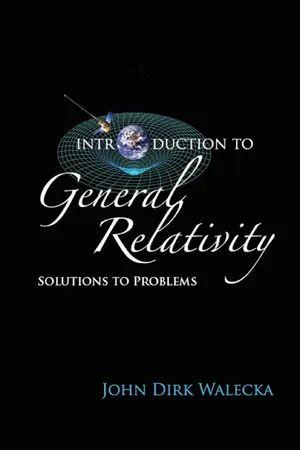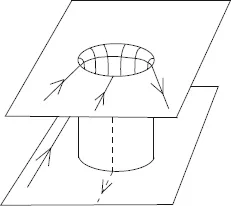
- 216 pages
- English
- ePUB (mobile friendly)
- Available on iOS & Android
About this book
-->
It is important for every physicist today to have a working knowledge of Einstein's theory of general relativity. Introduction to General Relativity published in 2007 was aimed at first-year graduate students, or advanced undergraduates, in physics. Only a basic understanding of classical lagrangian mechanics is assumed; beyond that, the reader should find the material to be self-contained.
The mechanics problem of a point mass constrained to move without friction on a two-dimensional surface of arbitrary shape serves as a paradigm for the development of the mathematics and physics of general relativity. Special relativity is reviewed. The basic principles of general relativity are then presented, and the most important applications are discussed. The final special topics section takes the reader up to a few areas of current research. An extensive set of accessible problems enhances and extends the coverage.
As a learning and teaching tool, this current book provides solutions to those problems. This text and solutions manual are meant to provide an introduction to the subject. It is hoped that these books will allow the reader to approach the more advanced texts and monographs, as well as the continual influx of fascinating new experimental results, with a deeper understanding and sense of appreciation.
-->
Request Inspection Copy
--> Contents:
- Preface
- Introduction
- Particle on a Two-Dimensional Surface
- Curvilinear Coordinate Systems
- Particle on a Two-Dimensional Surface–Revisited
- Some Tensor Analysis
- Special Relativity
- General Relativity
- Precession of Perihelion
- Gravitational Redshift
- Neutron Stars
- Cosmology
- Gravitational Radiation
- Special Topics
- Appendices:
- Reduction of g μν δR μν to Covariant Divergences
- Robertson-Walker Metric with k ≠ 0
- Bibliography
- Index
-->
--> Readership: Advanced undergraduate or graduate students in mathematical and theoretical physics. -->
General Relativity;Special Relativity;Riemannian Geometry;Precession of Perihelion;Gravitational Redshift;Neutron Stars;Black Holes;Cosmology;Gravitational Waves;Cosmological Constant;Inflation0
Frequently asked questions
- Essential is ideal for learners and professionals who enjoy exploring a wide range of subjects. Access the Essential Library with 800,000+ trusted titles and best-sellers across business, personal growth, and the humanities. Includes unlimited reading time and Standard Read Aloud voice.
- Complete: Perfect for advanced learners and researchers needing full, unrestricted access. Unlock 1.4M+ books across hundreds of subjects, including academic and specialized titles. The Complete Plan also includes advanced features like Premium Read Aloud and Research Assistant.
Please note we cannot support devices running on iOS 13 and Android 7 or earlier. Learn more about using the app.
Information
Chapter 1
Introduction
Chapter 2
Particle on a Two-Dimensional Surface
Solution to Problem 2.1

Chapter 3
Curvilinear Coordinate Systems
Solution to Problem 3.1








Solution to Problem 3.2









Table of contents
- Cover
- Halftitle
- Title
- Copyright
- Preface
- Contents
- 1. Introduction
- 2. Particle on a Two-Dimensional Surface
- 3. Curvilinear Coordinate Systems
- 4. Particle on a Two-Dimensional Surface–Revisited
- 5. Some Tensor Analysis
- 6. Special Relativity
- 7. General Relativity
- 8. Precession of Perihelion
- 9. Gravitational Redshift
- 10. Neutron Stars
- 11. Cosmology
- 12. Gravitational Radiation
- 13. Special Topics
- Appendix A Reduction of gµν δRµν to Covariant Divergences
- Appendix B Robertson-Walker Metric with k ≠ 0
- Bibliography
- Index